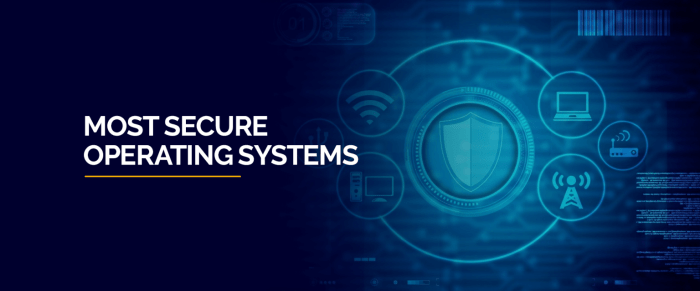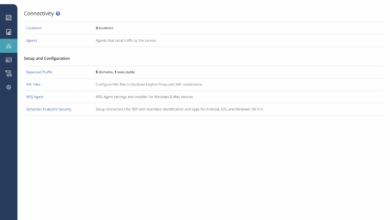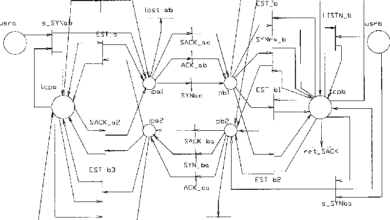The Myth of the Secure OS A Deceptive Reality
The myth of the secure operating system pervades our digital landscape, promising impenetrable defenses against cyber threats. But how realistic is this promise? This exploration delves into the common misconceptions surrounding operating system security, revealing the stark contrast between the idealized image and the often-vulnerable reality. We’ll uncover the underlying vulnerabilities, the role of user behavior, technological limitations, and the ongoing security paradox, ultimately examining practical mitigation strategies and future trends.
From historical exploits to contemporary vulnerabilities, we’ll analyze the factors that contribute to the persistent myth. This isn’t just about theoretical discussions; it’s about understanding how our systems are truly vulnerable and what we can do to protect ourselves.
Defining the Myth: The Myth Of The Secure Operating System
The myth of the secure operating system posits a false sense of invincibility, portraying an operating system (OS) as an impenetrable fortress against all cyberattacks. This belief often stems from the inherent complexity of OS code and the sophistication of modern security measures. However, this perception is far removed from the reality of ongoing vulnerabilities and the constant evolution of attack vectors.This idealized view of OS security often overlooks the crucial role of human factors, software updates, and the dynamic nature of the threat landscape.
Operating systems, despite their best efforts, are not infallible, and attackers continuously find creative ways to exploit weaknesses.
Common Misconceptions
Operating systems are frequently perceived as the primary defense against all cyber threats. This oversimplification ignores the multifaceted nature of security, where OS vulnerabilities are just one piece of a larger puzzle. Critical vulnerabilities in applications running on top of the OS, or user misconfigurations, often pose a greater threat than flaws in the core OS code.
Historical and Contemporary Vulnerabilities, The myth of the secure operating system
Operating systems have a long history of security vulnerabilities. From the infamous Melissa virus exploiting Microsoft Outlook to the Spectre and Meltdown vulnerabilities affecting modern processors and impacting many OSes, security flaws have consistently emerged. The constant arms race between attackers and developers highlights the dynamic nature of the threat landscape and the ever-present need for vigilance in software development.
Examples like the Heartbleed bug, which exposed sensitive data through a flaw in OpenSSL, demonstrate the potential for widespread damage caused by seemingly minor flaws.
Perception vs. Reality of Exploits
The perception of operating system security often contrasts sharply with the reality of potential exploits. While OS vendors implement rigorous security protocols and conduct extensive testing, vulnerabilities are inevitably discovered, and attackers often find innovative ways to exploit them. The complexity of modern software, the constantly evolving attack surface, and the sheer volume of code make it practically impossible to eliminate all potential flaws.
The public perception is often that an OS is secure if it’s well-maintained and up-to-date, but that’s a significantly simplified view of a multifaceted problem.
Idealized OS vs. Actual Capabilities
| Idealized Image of an OS | Actual Capabilities of an OS in Preventing Attacks |
|---|---|
| An impenetrable fortress, immune to all attacks. | A robust, but not impenetrable, defense, constantly under pressure from evolving threats. |
| Security is solely the responsibility of the OS vendor. | Security is a shared responsibility between the OS vendor, application developers, and end-users. |
| Security updates resolve all vulnerabilities. | Security updates address known vulnerabilities, but new threats emerge constantly. |
| Regular updates maintain perfect security. | Regular updates improve security posture but don’t guarantee absolute invulnerability. |
“The myth of the secure operating system is a dangerous oversimplification that can lull users into a false sense of security.”
Underlying Vulnerabilities
The myth of the secure operating system often stems from a flawed understanding of its limitations. While operating systems strive for security, inherent weaknesses and design choices create vulnerabilities that attackers can exploit. This section delves into the fundamental flaws contributing to this pervasive misconception.Operating systems are complex pieces of software, making them susceptible to vulnerabilities. Their core functionality, while designed for reliability and stability, can be compromised by vulnerabilities in their architecture and implementation.
This complexity, while essential for the system’s functionality, also presents a larger attack surface.
Fundamental Weaknesses
The complexity of an operating system introduces numerous points of potential failure. These weaknesses range from flaws in the design of the system’s security mechanisms to vulnerabilities in the implementation of its code. The sheer volume of code, combined with the intricate interactions between different parts of the system, creates a breeding ground for security flaws. Security vulnerabilities can manifest as flaws in access controls, buffer overflows, or flaws in the handling of input data.
Role of Design Choices in Creating Vulnerabilities
Design choices play a significant role in the security posture of an operating system. For example, prioritizing performance over security can lead to design decisions that inadvertently create vulnerabilities. The trade-off between security and usability can result in vulnerabilities that are difficult to detect or mitigate. Similarly, the use of legacy code or components can introduce vulnerabilities that were not anticipated during the initial design phase.
Impact of Software Complexity on Security
As software grows more complex, the potential for security vulnerabilities increases exponentially. The sheer number of lines of code, interactions between modules, and intricate dependencies make it increasingly difficult to thoroughly test and validate the system’s security. This leads to a greater risk of undiscovered flaws that can be exploited by attackers. The complexity of modern operating systems necessitates the use of advanced security testing methodologies and a robust vulnerability management process to address these inherent risks.
A classic example is the complexity of the Linux kernel, which, despite its robustness, has experienced numerous vulnerabilities over time.
Common Attack Vectors Targeting Operating Systems
Operating systems are targeted through various attack vectors, each exploiting specific vulnerabilities. These attacks often target the system’s core components, such as the kernel, or specific services that are running on the system.
- Exploiting Software Bugs: Malicious actors frequently exploit known software bugs to gain unauthorized access. These bugs can manifest as vulnerabilities in the operating system itself or in applications running on top of it. For instance, buffer overflows allow attackers to inject arbitrary code into the system, potentially granting them control.
- Social Engineering Attacks: While not directly targeting the OS, social engineering attacks can manipulate users into providing sensitive information, which can then be used to compromise the operating system. Phishing attacks, for example, can deceive users into revealing login credentials or downloading malicious software.
- Hardware Vulnerabilities: Physical access to the system, such as through side-channel attacks, allows attackers to exploit vulnerabilities in the hardware or its interaction with the operating system. These attacks can target the system’s memory, timing, or power consumption patterns. For example, attackers might use a specialized tool to monitor the system’s power consumption to glean information about the operations it’s performing.
Summary of Attack Vectors and Impacts
| Attack Type | Description | Potential Impact |
|---|---|---|
| Buffer Overflow | Exploiting a buffer’s size limitations to inject malicious code. | System compromise, code execution, data breaches. |
| SQL Injection | Injecting malicious SQL code into an application’s queries. | Data breaches, unauthorized access to databases. |
| Cross-Site Scripting (XSS) | Injecting malicious scripts into web pages viewed by other users. | Session hijacking, data theft, website defacement. |
| Denial-of-Service (DoS) | Overwhelming a system with traffic to prevent legitimate users from accessing it. | Service disruption, business loss, loss of availability. |
The Role of User Behavior

The myth of a secure operating system often overlooks a crucial component: the human element. While robust security measures are essential, they are ultimately ineffective if users consistently engage in risky behaviors. User actions, both intentional and unintentional, significantly impact the overall security posture of a system. This section delves into the pervasive role of user behavior in perpetuating, or undermining, the perception of security.
User Actions Contributing to the Security Myth
User actions play a significant role in shaping the perceived security of an operating system. Users frequently contribute to security vulnerabilities through various behaviors, ranging from simple negligence to deliberate malicious intent. A significant portion of security breaches are attributed to human error, emphasizing the critical need for user awareness and training.
Common Security Pitfalls
Users frequently fall prey to several common security pitfalls. These include, but are not limited to, poor password management practices, failing to update software, clicking on suspicious links, and sharing sensitive information with untrusted sources. These seemingly minor actions can have severe consequences, leading to data breaches, financial losses, and reputational damage.
Security Risks Associated with User Actions
The table below illustrates different user actions and their corresponding security risks. Understanding these potential consequences can empower users to make more informed decisions.
| User Action | Security Risk |
|---|---|
| Using weak or easily guessed passwords | Unauthorized access to accounts, sensitive data compromise |
| Ignoring software updates | Exposure to known vulnerabilities, exploitation by malicious actors |
| Clicking on phishing links or attachments | Malware infection, data theft, financial fraud |
| Sharing sensitive information with untrusted sources | Identity theft, data breaches, unauthorized access |
| Using the same password across multiple accounts | Compromise of multiple accounts if one account is breached |
| Not enabling multi-factor authentication | Increased risk of unauthorized access even if the password is compromised |
| Ignoring security warnings | Failure to address potential threats, exposing systems to risks |
User Training and Security Improvement
Effective user training is crucial for improving security posture. Training programs should focus on educating users about common security threats and best practices. Practical examples and interactive exercises can enhance comprehension and retention. By equipping users with the necessary knowledge and skills, organizations can mitigate the risks associated with human error and significantly bolster their overall security.
For instance, simulated phishing attacks can help users recognize and avoid fraudulent attempts. Regular reminders about strong password policies, secure browsing practices, and the importance of software updates are essential components of effective security training.
Technological Limitations
The myth of the secure operating system often hinges on the idea that sophisticated technology can entirely eliminate vulnerabilities. However, the reality is far more complex, highlighting inherent limitations in current security technologies and the ever-evolving nature of threats. These limitations, combined with the constant arms race between attackers and defenders, contribute to the ongoing challenge of achieving true security.The inherent limitations of current security technologies stem from several key factors.
First, security systems are often reactive rather than proactive. They respond to known threats, but new threats constantly emerge, leaving existing defenses vulnerable. Second, security technologies rely on algorithms and heuristics, which can be circumvented or exploited by attackers with sufficient resources and ingenuity. Finally, the sheer complexity of modern software and hardware systems introduces numerous entry points for attackers, making it virtually impossible to create a completely impenetrable system.
Let’s be real, the myth of the secure operating system is just that – a myth. While robust security measures are crucial, no OS is truly impenetrable. Companies often need sophisticated tools to track digital assets, like the ones detailed in Helping Corporations Track Digital Content A Comprehensive Guide. Understanding how data flows and who accesses it is vital, and these tools can help mitigate risks even with less-than-perfect operating systems.
This is a key element in any security strategy, highlighting the importance of comprehensive approaches to safeguarding digital information.
Limitations of Current Security Measures
Current security measures, while effective against many known threats, are not foolproof. Firewalls, intrusion detection systems, and antivirus software are all critical tools, but they are not impenetrable barriers. Attackers can exploit vulnerabilities in these systems or bypass them altogether through sophisticated techniques like social engineering or zero-day exploits. Furthermore, the constant evolution of malware and attack vectors necessitates continuous updates and improvements to security measures, often leaving systems vulnerable during the transition periods.
The idea of a “secure operating system” is often a bit of a myth, isn’t it? While they strive for robustness, real-world attacks like the recent “worm takes toll microsoft attack set” worm takes toll microsoft attack set highlight how vulnerabilities can quickly appear and exploit weaknesses. Ultimately, no OS is truly impenetrable, and security relies on a layered approach beyond the core software itself.
The Arms Race and Evolving Threats
The relationship between attackers and defenders is akin to an arms race. As defenders develop new security measures, attackers develop new ways to bypass them. This constant back-and-forth creates a dynamic landscape where existing defenses become obsolete over time. For example, the emergence of polymorphic malware, which constantly changes its code to evade detection, necessitates sophisticated and adaptable security measures to remain effective.
This arms race highlights the inherent limitation of relying solely on static security solutions.
The myth of a truly secure operating system persists, even as hardware innovation continues. Sony’s new Clié PDAs, which will use their in-house chip here , highlight this ongoing tension. While these custom chips might offer some security advantages, the truth is that security hinges on more than just the hardware. Ultimately, the operating system is just one piece of a complex puzzle, and even the most advanced tech can be vulnerable if the software isn’t meticulously crafted and constantly updated.
Threat Evolution vs. Security Measures
| Threat Evolution | Security Measures |
|---|---|
| Rise of polymorphic malware | Development of advanced heuristic analysis and machine learning-based detection systems |
| Sophisticated social engineering attacks | Improved user awareness training and multi-factor authentication |
| Exploitation of vulnerabilities in complex software ecosystems | Focus on secure software development practices and rigorous vulnerability assessments |
| Quantum computing advancements | Development of quantum-resistant cryptography |
The table above illustrates the dynamic relationship between the evolution of threats and the corresponding security measures. Notice the continuous adaptation required to counter emerging threats. This underscores the need for ongoing innovation and proactive security strategies.
The Impermanence of Security
The ongoing arms race between attackers and defenders emphasizes the impermanence of security. No system, no matter how sophisticated, can be considered truly secure in the long term. Security is a continuous process, not a one-time solution. Security measures must be constantly adapted and improved to address new and evolving threats. The continuous cycle of threat emergence and countermeasure development ensures that the fight against malicious actors remains an ongoing challenge.
The Security Paradox

The promise of a secure operating system often feels like a utopian ideal. We envision impenetrable fortresses against cyber threats, but the reality is far more complex. Security is not a static state, but a dynamic, ongoing battle against ever-evolving vulnerabilities. The very nature of software, with its intricate code and dependencies, creates inherent weaknesses. This ongoing tension between the idealized security and the practical realities of attack is the security paradox.The allure of a secure operating system rests on the promise of complete protection against malicious actors.
This promise, however, is inherently flawed. Security is not a destination; it’s a journey. A one-time fix is a myth. Attack vectors shift, new vulnerabilities emerge, and existing protections become obsolete. Security, therefore, must be treated as a continuous process, requiring constant vigilance, adaptation, and improvement.
Operating System Security as a Continuous Process
Security is an iterative process. Patches are released to address newly discovered vulnerabilities, and these patches themselves introduce the potential for new issues. Security researchers, developers, and users must continuously adapt to the changing threat landscape. The dynamic nature of the digital world necessitates a proactive approach, constantly evaluating and strengthening defenses.
Factors Contributing to OS Security Complexity
The intricate design of modern operating systems introduces several layers of complexity. A multitude of components, from the kernel to applications, interact and rely on each other, creating a complex web of dependencies. This interconnectedness can introduce vulnerabilities at unexpected points. Furthermore, the sheer size and scope of codebases in modern operating systems create a larger attack surface, increasing the likelihood of undetected flaws.
The need for compatibility with older systems, or legacy code, often presents further complications. Maintaining a robust security posture while simultaneously maintaining compatibility presents a challenge that requires constant balancing.
- Code Complexity: Modern operating systems often contain millions of lines of code, making it difficult to thoroughly test and identify all potential vulnerabilities. The intricacy of interactions between various components can lead to unforeseen vulnerabilities.
- Dependency Management: Operating systems rely on numerous libraries and components from third-party vendors. Security flaws in these dependencies can be exploited, impacting the entire system. Ensuring the security of all dependencies is a significant challenge.
- Hardware Vulnerabilities: The underlying hardware can also contain vulnerabilities that can be exploited to bypass or circumvent software protections. The increasing reliance on specialized hardware components introduces new avenues for attacks.
- Evolving Threat Landscape: Cybercriminals constantly develop new and sophisticated attack techniques. Operating system security must adapt to these evolving threats, which often involve social engineering, zero-day exploits, and novel attack vectors.
Ongoing Efforts to Improve OS Security
Significant efforts are underway to strengthen operating system security. These include enhanced security features, improved vulnerability detection mechanisms, and increased collaboration among security researchers and developers. The development of automated tools for vulnerability analysis and the deployment of advanced threat intelligence are examples of these proactive measures. Open-source initiatives and community involvement play a crucial role in discovering and mitigating vulnerabilities.
Companies are constantly investing in research and development, seeking to create more secure systems from the ground up.
Mitigation Strategies
The myth of the secure operating system, despite its allure, is ultimately a fallacy. Real-world security relies on a multifaceted approach, acknowledging the inherent vulnerabilities within any system and the crucial role of human factors. This section explores practical strategies for mitigating the myth and building a more resilient security posture.Effective mitigation requires a proactive approach, moving beyond reactive measures.
By understanding and addressing the weaknesses in both technology and human behavior, organizations and users can significantly enhance their security. This proactive approach, while challenging, is essential to avoid falling victim to security exploits.
Practical Strategies for Users
User education and awareness are critical components of any security strategy. Users need to be equipped with the knowledge and skills to identify and avoid potential threats.
- Strong Password Management: Implementing strong, unique passwords for each account is fundamental. Using password managers can help generate and store complex passwords, significantly reducing the risk of breaches. Regularly updating passwords, especially after security incidents, is also crucial.
- Phishing Awareness: Recognizing phishing attempts is vital. Users should be cautious of suspicious emails, messages, or websites requesting personal information. Training on identifying common phishing tactics, such as spoofed email addresses and urgent requests for data, is essential. Users should verify requests directly with the supposed sender, rather than clicking links or providing information.
- Software Updates: Keeping software updated with the latest security patches is crucial. Outdated software often contains vulnerabilities that attackers can exploit. Implementing automatic updates whenever possible minimizes the attack surface.
Proactive Measures for Administrators
Administrators play a pivotal role in maintaining a secure environment. Their actions significantly influence the overall security posture of a system.
- Regular Security Audits: Performing regular security audits helps identify potential weaknesses and vulnerabilities within the system. These audits should encompass both technical aspects, such as network configurations and software versions, and procedural aspects, like user access controls and incident response plans. This proactive approach ensures that security measures remain up-to-date and effective.
- Robust Access Control: Implementing a robust access control system restricts unauthorized access to sensitive data and resources. This involves using strong authentication mechanisms, such as multi-factor authentication, and regularly reviewing and adjusting access privileges based on user roles and responsibilities. Least privilege access principles should be implemented to limit the potential impact of security breaches.
- Incident Response Plan: Developing and regularly testing an incident response plan is essential. A well-defined plan Artikels the steps to take in case of a security incident, ensuring a coordinated and efficient response. This proactive measure helps minimize damage and downtime.
Security Awareness Training
Security awareness training programs equip users with the knowledge and skills to recognize and avoid potential threats. These programs should be ongoing and adaptable to evolving threats.
- Regular Training Sessions: Implementing regular training sessions that cover current threats and best practices is crucial. This ensures users are up-to-date with the latest security threats and have the knowledge to protect themselves and the organization.
- Simulations and Exercises: Conducting phishing simulations and other security exercises helps users identify and respond to security threats in a controlled environment. This allows for practice and feedback to enhance their skills and improve their security posture.
Security Tool Comparison
A comprehensive security strategy often involves a suite of security tools. Comparing their effectiveness is essential for choosing the right tools for a specific environment.
| Tool | Effectiveness | Use Cases |
|---|---|---|
| Firewall | High (if properly configured) | Network security, blocking unauthorized access |
| Antivirus Software | Moderate (effectiveness depends on definition updates) | Identifying and removing malware |
| Intrusion Detection System (IDS) | Moderate to High (depending on configuration) | Detecting malicious activities |
| Security Information and Event Management (SIEM) | High (for comprehensive analysis) | Centralized logging and monitoring |
Note: Effectiveness ratings are subjective and depend on factors such as proper configuration and up-to-date definitions.
Staying Up-to-Date on Security Best Practices
Staying abreast of evolving security threats and best practices is crucial for maintaining a secure environment. Continuously learning and adapting to new challenges is paramount.
- Security News Sources: Following reputable security news sources and blogs provides insights into emerging threats and security vulnerabilities. Staying informed about industry trends and best practices is essential for proactive security.
- Security Conferences and Workshops: Attending security conferences and workshops provides opportunities to learn from experts and network with other security professionals. This continuous learning can significantly enhance one’s security knowledge and understanding.
Future Trends
The myth of the secure operating system, despite valiant efforts, persists. The constant evolution of both attack vectors and defensive technologies necessitates a forward-thinking approach to security. Anticipating future threats and adapting our strategies is crucial for building resilient systems. This involves not only understanding emerging technologies but also recognizing how existing vulnerabilities can be exploited in novel ways.
Potential Advancements in Operating System Security
Future advancements in operating system security are likely to focus on more sophisticated defenses. This includes proactive threat modeling, real-time threat detection, and enhanced intrusion prevention systems (IPS). AI and machine learning will likely play a critical role in identifying and mitigating emerging threats. Furthermore, a shift towards more decentralized and modular operating systems might prove beneficial.
This allows for faster patching and easier isolation of compromised components.
Evolution of Attack Techniques and Countermeasures
Attack techniques are continually evolving. Sophisticated attacks are leveraging vulnerabilities in hardware, software, and human behavior. Quantum computing, for example, presents a potential threat to current encryption methods. Therefore, developing quantum-resistant cryptography is essential. Countermeasures must evolve to address these challenges, including advanced security audits, improved vulnerability management, and enhanced security training for users.
Importance of Anticipating Future Threats
Anticipating future threats is critical to staying ahead of attackers. This requires ongoing research and development, proactive security measures, and a flexible approach to adapting to new technologies and attack methods. The evolution of artificial intelligence (AI), for instance, necessitates the development of AI-resistant security protocols. By analyzing past trends and emerging technologies, we can better predict and prepare for future threats.
Potential Future Security Challenges
| Category | Challenge Description | Example ||—|—|—|| Hardware Vulnerabilities | Exploiting vulnerabilities in the physical architecture of systems, potentially leading to hardware-level attacks. | Side-channel attacks targeting specialized hardware components for sensitive information leakage. || Software Supply Chain Attacks | Malicious code introduced into legitimate software packages during development, testing, or distribution. | Compromising open-source libraries or tools, leading to broader infections.
|| Quantum Computing Threats | The potential for quantum computers to break current encryption algorithms, rendering existing security measures ineffective. | Breaking RSA encryption, compromising sensitive data stored using RSA-based systems. || AI-Powered Attacks | Using AI to automate and refine attack strategies, making them more difficult to detect and counter. | Developing sophisticated phishing campaigns with tailored messages to exploit user trust.
|| Internet of Things (IoT) Security | Securing a rapidly expanding network of interconnected devices, creating numerous potential entry points for malicious actors. | Exploiting vulnerabilities in smart home devices to gain access to the network. |
Preparing for Emerging Threats
Preparing for emerging threats requires a multi-faceted approach. This includes investing in research and development of advanced security technologies, promoting collaboration between security researchers and developers, and implementing proactive security measures. Continuous learning and adaptation are crucial. Organizations need to foster a security-conscious culture within their teams, emphasizing the importance of awareness and vigilance. Furthermore, fostering open communication channels and knowledge sharing within the security community is paramount to addressing these challenges.
Final Wrap-Up
Ultimately, the myth of the secure operating system highlights a critical truth: security is not a static state, but a continuous process. While operating systems strive for enhanced protection, the ever-evolving nature of threats demands a proactive and holistic approach. Understanding the vulnerabilities, acknowledging user responsibility, and embracing ongoing adaptation are crucial steps toward a more secure digital future.
This exploration underscores the importance of vigilance and continuous learning in navigating the complex world of cybersecurity.







